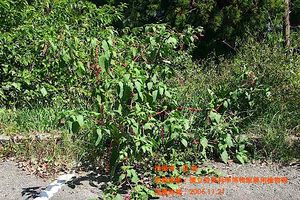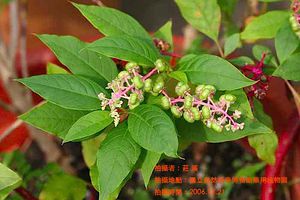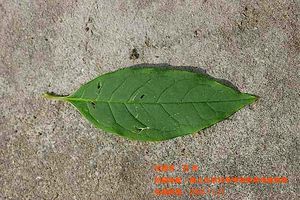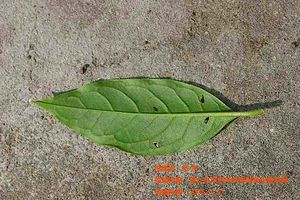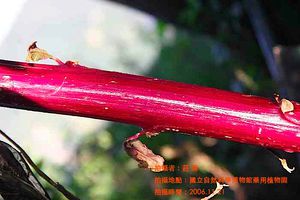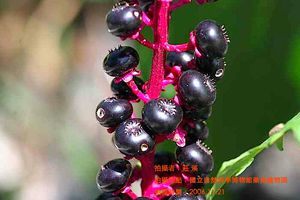美洲商陸
出自台灣有毒中草藥毒性資料庫
(→蒼耳(蒼耳子)簡介) |
(→毒性研究) |
||
| (17個中途的修訂版本沒有顯示) | |||
| 第1行: | 第1行: | ||
| - | [http://tcm-toxic.kmu.edu.tw/index.php/%E5% | + | __NOTOC__ |
| + | {| | ||
| + | ||[http://tcm-toxic.kmu.edu.tw/index.php/%E5%AD%B8%E5%90%8D 中英文學名] | ||
| + | ||[http://tcm-toxic.kmu.edu.tw/index.php/%E5%95%86%E9%99%B8%E7%A7%91 科別] | ||
| + | |||
| + | ||[http://tcm-toxic.kmu.edu.tw/index.php/%E6%AF%92%E6%80%A7 毒性] | ||
| + | |||
| + | ||[http://tcm-toxic.kmu.edu.tw/index.php/%E7%97%87%E7%8B%80 症狀] | ||
| + | |} | ||
== '''基本資料''' == | == '''基本資料''' == | ||
{| border="2" style="border-collapse;" | {| border="2" style="border-collapse;" | ||
|| | || | ||
| - | <font size= | + | <font size=4>'''科別'''</font> |
| - | ||<font size= | + | ||<font size=4>商陸科 Phytolaccaceae</font> |
|- | |- | ||
|| | || | ||
| - | <font size= | + | <font size=4>'''屬名'''</font> |
| - | ||<font size= | + | ||<font size=4>商陸屬 ''Phytolacca'' L.</font> |
|- | |- | ||
|| | || | ||
| - | <font size= | + | <font size=4>'''中文學名'''</font> |
| - | ||<font size= | + | ||<font size=4>美洲商陸</font> |
|- | |- | ||
|| | || | ||
| - | <font size= | + | <font size=4>'''拉丁學名'''</font> |
| - | ||<font size= | + | ||<font size=4>''Phytolacca americana'' L.</font> |
|- | |- | ||
|| | || | ||
| - | <font size= | + | <font size=4>'''英文名稱'''</font> |
| - | ||<font size= | + | ||<font size=4>Poke Salet, American Pokeweed, Cancer-root, Cancer jalap, Inkberry, Pigeon Berry, Pocan, Poke, Poke Root, Pokeberry, Reujin D Ours, Sekerciboyaci, Skoke, Virginian Poke, Yoshu-Yama-Gobo, Yyamilin</font> |
|- | |- | ||
|| | || | ||
| - | <font size= | + | <font size=4>'''中文俗名'''</font> |
| - | ||<font size= | + | ||<font size=4>洋商陸、野胭脂、美國商陸</font> |
|} | |} | ||
| + | [1-3] | ||
| + | |||
== '''植物圖片''' == | == '''植物圖片''' == | ||
| + | <font size=4> | ||
{| border="2" style="border-collapse;" | {| border="2" style="border-collapse;" | ||
|| | || | ||
| - | [[檔案: | + | [[檔案:美商陸01.jpg |300px|美洲商陸全株]] |
| - | + | 美洲商陸全株 | |
|| | || | ||
| - | [[檔案: | + | [[檔案: 美洲商陸0.jpg|300px|美洲商陸]] |
| - | + | 美洲商陸 | |
|| | || | ||
| - | [[檔案: | + | [[檔案:美洲商陸-葉1.jpg|300px|美洲商陸葉正]] |
| - | + | 美洲商陸葉正 | |
|| | || | ||
|- | |- | ||
|| | || | ||
| - | [[檔案: | + | [[檔案: 美洲商陸-葉0.jpg|300px|美洲商陸葉背]] |
| - | + | 美洲商陸葉背 | |
|| | || | ||
| - | [[檔案: | + | [[檔案: 美商陸-莖0.jpg|300px|美洲商陸莖]] |
| - | + | 美洲商陸莖 | |
|| | || | ||
| - | [[檔案: | + | [[檔案: 美商陸-黑實0.jpg|300px|美洲商陸成熟果實]] |
| - | + | 美洲商陸成熟果實 | |
|} | |} | ||
| + | </font> | ||
== '''美洲商陸簡介''' == | == '''美洲商陸簡介''' == | ||
| + | <font size=4>美洲商陸在藥用植物當中,根被用來催吐、利尿或是治風濕、水腫,而種子則用於利尿,葉片解熱、治腳氣[1]。使用前通常先需經過炮制,如醋浸或生切曬乾,始可用[2]。外觀上易與人參混淆,因此又有土人參之稱[4]。 | ||
| + | </font> | ||
| - | |||
== '''外觀簡述''' == | == '''外觀簡述''' == | ||
{| border="2" style="border-collapse;" | {| border="2" style="border-collapse;" | ||
|| | || | ||
| - | <font size= | + | <font size=4>'''莖'''</font> |
| - | ||<font size= | + | ||<font size=4>草本植物,植株高約 1~2 公尺,根肥大,肉質,莖粗亦多肉質,圓柱形,帶紫紅色,光滑無毛;莖直立或披散多分枝。 </font> |
|- | |- | ||
|| | || | ||
| - | <font size= | + | <font size=4>'''葉'''</font> |
| - | ||<font size= | + | ||<font size=4> 葉互生,具短柄,長約 2~3 公分,長橢圓形或卵狀長橢圓形,長 10~30 公分,寬 5~15 公分,兩端漸尖,基部楔形而下延,紙質,無毛,全緣。 </font> |
|- | |- | ||
|| | || | ||
| - | <font size= | + | <font size=4>'''花'''</font> |
| - | ||<font size= | + | ||<font size=4> 花為總狀花序,穗狀,頂生或與葉對生,傾斜,果熟下垂;長達 20 公分,兩性花,花淡粉紅色,小花柄長 0.7~1 公分,花被片 5 枚,白色而微帶紅色,雄蕊 10 枚,雌蕊 10 枚。花期夏、秋間。 </font> |
|- | |- | ||
|| | || | ||
| - | <font size= | + | <font size=4>'''果實'''</font> |
| - | ||<font size= | + | ||<font size=4> 果序下垂,軸不增粗,漿果扁球形,徑約 0.7~0.8 公分,萼宿存,通常由 8~10 個分果組成,成熟後呈紫黑色,多汁液;種子腎形,扁平,黑色。 </font> |
|} | |} | ||
| - | |||
== '''產地''' == | == '''產地''' == | ||
| - | <font size= | + | <font size=4>多生於陸旁、山溝、林緣、疏林等較為潮溼的地方。台灣分布於基隆、台北、桃園的平野至山地[1, 2]。 |
| + | </font> | ||
== '''毒性研究''' == | == '''毒性研究''' == | ||
| - | <font size= | + | <font size=4>目前已被研究出來的成分種類多為triterpene saponin (如phytolaccasaponins N-1, N-2, N-3, N-4, N-5)[5],1949年Jenkin[6]等人經由成份分離找到美洲商陸最主要的有毒成份phytolaccatoxin,後續研究以商陸水浸劑、煎劑及酊劑灌服小鼠,得三種劑型的LD50分別為26.0、28.0及46.5 克/公斤,而以腹腔注射分別為1.05、1.5及5.3克/公斤,但商陸經煮沸兩小時後,對於小鼠的毒性有明顯降低。 |
| + | </font> | ||
| - | *<font size= | + | *<font size=4, color=green>'''症狀'''</font> <font size=4> |
| - | <font size= | + | 服用商陸後,中毒症狀通常在30分鐘至3小時內會出現,症狀可分為三類型 |
| + | **消化系統症狀,如噁心、嘔吐、腹痛、腹瀉、 | ||
| + | **神經系統症狀,如頭痛、暈眩、四肢肌肉抽搐、震顫、 神智恍惚、呼吸中樞抑制、體溫上升、口齒不清、躁動不安、譫妄、昏迷、大小便失禁 | ||
| + | **心血管症狀,如血壓下降、心跳變緩、心臟麻痺死亡、血壓上升、脈搏加快等</font | ||
| - | *<font size= | + | *<font size=4, color=green>'''毒性成分'''</font> |
| - | + | **<font size=4>phytolaccatoxin[5]</font> | |
| - | + | ||
| - | *<font size= | + | |
| - | + | ||
=='''治療方式'''== | =='''治療方式'''== | ||
| - | <font size= | + | <font size=4> |
| + | 1.洗胃將剩餘物質洗出,服用雞蛋清、澱粉糊、活性炭等吸附有毒物質,並補充液體及維生素C,或加入1%的亞甲藍100毫升靜脈滴注。 | ||
| + | |||
| + | 2. 菖蒲、黃柏、川楝子各9克,元胡12克,以水煎服[3]。 | ||
| + | </font> | ||
=='''毒性分級'''== | =='''毒性分級'''== | ||
| - | <font size= | + | <font size=4>[http://tcm-toxic.kmu.edu.tw/index.php/%E6%AF%92%E6%80%A7%E5%88%86%E9%A1%9E 級數B]</font> |
== '''參考文獻''' == | == '''參考文獻''' == | ||
| + | <font size=4> | ||
| + | 1. 行政院衛生署中醫藥委員會. 臺灣藥用植物資源名錄. 臺北: 行政院衛生署中醫藥委員會 2003, p.p.190. | ||
| - | + | 2. 楊倉良. 毒藥本草. 中國中醫藥出版社 1993, p.p.510-515. | |
| - | + | 3. 高粶汶. 有毒中藥臨床精要. 學苑出版社 2006, p.p.313-317. | |
| - | + | 4. 夏建海, 闫克杰, 张金华, 丁东红, 夏宛平, 任方红. [http://www.ceps.com.tw/ec/ecjnlarticleView.aspx?jnlcattype=0&jnlptype=0&jnltype=0&jnliid=5014&issueiid=108316&atliid=2321167 商陆中毒3例临床分析.] ''中國民族民間醫藥'' 2010; 19: 179-179. | |
| - | + | 5. Wang L, Bai L, Nagasawa T, Hasegawa T, Yang X, Sakai J, Bai Y, Kataoka T, Oka S, Hirose K, Tomida A, Tsuruo T, Ando M. [http://www.ncbi.nlm.nih.gov/pubmed/18177012 Bioactive triterpene saponins from the roots of ''Phytolacca americana''.] ''Journal of Natural Products'' 2008; 71: 35-40. | |
| - | + | 6. YASUHARU S, YOHKO M, SACHIKO K, JUNZO S. [http://openagricola.nal.usda.gov/Record/CAIN789091728 Studies on the Constituents of Phytolaccaceous Plants. I. On the Structures of Phytolaccasaponin B, E and G from the Roots of ''Phytolacca americana'' L.] ''Chemical & pharmaceutical bulletin'' 1978; 26: 520-525. | |
| + | </font> | ||
| - | |||
| - | + | {| | |
| + | ||[http://tcm-toxic.kmu.edu.tw/index.php/%E5%AD%B8%E5%90%8D 中英文學名] | ||
| - | + | ||[http://tcm-toxic.kmu.edu.tw/index.php/%E5%95%86%E9%99%B8%E7%A7%91 科別] | |
| - | + | ||[http://tcm-toxic.kmu.edu.tw/index.php/%E6%AF%92%E6%80%A7 毒性] | |
| - | + | ||[http://tcm-toxic.kmu.edu.tw/index.php/%E7%97%87%E7%8B%80 症狀] | |
| - | + | |} | |
| - | + | ||
| - | + | ||
| - | + | ||
| - | + | ||
| - | + | ||
| - | + | ||
| - | + | ||
| - | + | ||
| - | + | ||
| - | + | ||
| - | + | ||
| - | + | ||
| - | + | ||
| - | [http://tcm-toxic.kmu.edu.tw/index.php/% | + | |
在2012年12月1日 (六) 10:12的最新修訂版本
| 中英文學名 | 科別 | 毒性 | 症狀 |
基本資料
|
科別 | 商陸科 Phytolaccaceae |
|
屬名 | 商陸屬 Phytolacca L. |
|
中文學名 | 美洲商陸 |
|
拉丁學名 | Phytolacca americana L. |
|
英文名稱 | Poke Salet, American Pokeweed, Cancer-root, Cancer jalap, Inkberry, Pigeon Berry, Pocan, Poke, Poke Root, Pokeberry, Reujin D Ours, Sekerciboyaci, Skoke, Virginian Poke, Yoshu-Yama-Gobo, Yyamilin |
|
中文俗名 | 洋商陸、野胭脂、美國商陸 |
[1-3]
植物圖片
|
美洲商陸全株 |
美洲商陸 |
美洲商陸葉正 | |
|
美洲商陸葉背 |
美洲商陸莖 |
美洲商陸成熟果實 |
美洲商陸簡介
美洲商陸在藥用植物當中,根被用來催吐、利尿或是治風濕、水腫,而種子則用於利尿,葉片解熱、治腳氣[1]。使用前通常先需經過炮制,如醋浸或生切曬乾,始可用[2]。外觀上易與人參混淆,因此又有土人參之稱[4]。
外觀簡述
|
莖 | 草本植物,植株高約 1~2 公尺,根肥大,肉質,莖粗亦多肉質,圓柱形,帶紫紅色,光滑無毛;莖直立或披散多分枝。 |
|
葉 | 葉互生,具短柄,長約 2~3 公分,長橢圓形或卵狀長橢圓形,長 10~30 公分,寬 5~15 公分,兩端漸尖,基部楔形而下延,紙質,無毛,全緣。 |
|
花 | 花為總狀花序,穗狀,頂生或與葉對生,傾斜,果熟下垂;長達 20 公分,兩性花,花淡粉紅色,小花柄長 0.7~1 公分,花被片 5 枚,白色而微帶紅色,雄蕊 10 枚,雌蕊 10 枚。花期夏、秋間。 |
|
果實 | 果序下垂,軸不增粗,漿果扁球形,徑約 0.7~0.8 公分,萼宿存,通常由 8~10 個分果組成,成熟後呈紫黑色,多汁液;種子腎形,扁平,黑色。 |
產地
多生於陸旁、山溝、林緣、疏林等較為潮溼的地方。台灣分布於基隆、台北、桃園的平野至山地[1, 2]。
毒性研究
目前已被研究出來的成分種類多為triterpene saponin (如phytolaccasaponins N-1, N-2, N-3, N-4, N-5)[5],1949年Jenkin[6]等人經由成份分離找到美洲商陸最主要的有毒成份phytolaccatoxin,後續研究以商陸水浸劑、煎劑及酊劑灌服小鼠,得三種劑型的LD50分別為26.0、28.0及46.5 克/公斤,而以腹腔注射分別為1.05、1.5及5.3克/公斤,但商陸經煮沸兩小時後,對於小鼠的毒性有明顯降低。
- 症狀
服用商陸後,中毒症狀通常在30分鐘至3小時內會出現,症狀可分為三類型
- 消化系統症狀,如噁心、嘔吐、腹痛、腹瀉、
- 神經系統症狀,如頭痛、暈眩、四肢肌肉抽搐、震顫、 神智恍惚、呼吸中樞抑制、體溫上升、口齒不清、躁動不安、譫妄、昏迷、大小便失禁
- 心血管症狀,如血壓下降、心跳變緩、心臟麻痺死亡、血壓上升、脈搏加快等</font
- 毒性成分
- phytolaccatoxin[5]
治療方式
1.洗胃將剩餘物質洗出,服用雞蛋清、澱粉糊、活性炭等吸附有毒物質,並補充液體及維生素C,或加入1%的亞甲藍100毫升靜脈滴注。
2. 菖蒲、黃柏、川楝子各9克,元胡12克,以水煎服[3]。
毒性分級
參考文獻
1. 行政院衛生署中醫藥委員會. 臺灣藥用植物資源名錄. 臺北: 行政院衛生署中醫藥委員會 2003, p.p.190.
2. 楊倉良. 毒藥本草. 中國中醫藥出版社 1993, p.p.510-515.
3. 高粶汶. 有毒中藥臨床精要. 學苑出版社 2006, p.p.313-317.
4. 夏建海, 闫克杰, 张金华, 丁东红, 夏宛平, 任方红. 商陆中毒3例临床分析. 中國民族民間醫藥 2010; 19: 179-179.
5. Wang L, Bai L, Nagasawa T, Hasegawa T, Yang X, Sakai J, Bai Y, Kataoka T, Oka S, Hirose K, Tomida A, Tsuruo T, Ando M. Bioactive triterpene saponins from the roots of Phytolacca americana. Journal of Natural Products 2008; 71: 35-40.
6. YASUHARU S, YOHKO M, SACHIKO K, JUNZO S. Studies on the Constituents of Phytolaccaceous Plants. I. On the Structures of Phytolaccasaponin B, E and G from the Roots of Phytolacca americana L. Chemical & pharmaceutical bulletin 1978; 26: 520-525.
| 中英文學名 | 科別 | 毒性 | 症狀 |
